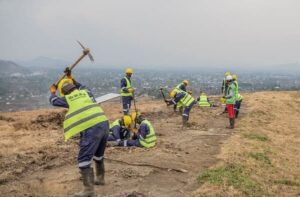
Raw Gold Mining in Africa. Discover how raw gold is Mined
Raw gold mining has long been a fascinating endeavor, captivating the imagination of individuals and nations alike. From ancient civilizations to modern-day operations, the pursuit of this precious metal has shaped economies, influenced cultures, and spurred technological innovation.
In this article, we delve into the intricate world of raw gold mining, examining its history, processes, environmental impact, economic significance, challenges, and future trends.
What is raw gold?
Raw gold, also known as native gold, is the unrefined form of the precious metal found in nature. It is typically found in nuggets or grains within rocks and sediment.
Importance of raw gold mining
Raw gold holds significant value due to its rarity, durability, and aesthetic appeal. It has been used for currency, jewelry, and ornamentation throughout history, making it a sought-after commodity.
History of Raw Gold Mining
Ancient civilizations and gold mining
Gold mining dates back thousands of years, with evidence of early mining operations found in regions such as Mesopotamia, Egypt, and Ancient Greece. These civilizations developed rudimentary techniques to extract gold from rivers, streams, and underground deposits.
Modern techniques and advancements
In modern times, gold mining has evolved with technological advancements, enabling more efficient extraction and processing methods. Industrial-scale mining operations utilize heavy machinery, chemical processes, and sophisticated equipment to access deeper deposits and extract smaller particles of gold.
Raw Gold Mining Process
- Exploration phase: The first step in raw gold mining involves exploration to identify potential gold-rich areas. This may involve geological surveys, remote sensing techniques, and drilling to assess the quality and quantity of gold deposits.
- Extraction methods: Once a viable deposit is discovered, various extraction methods are employed to remove the raw gold from the surrounding rock and sediment. These methods may include open-pit mining, underground mining, and placer mining, depending on the geological characteristics of the site.
- Processing and refining: After extraction, the raw gold undergoes processing and refining to remove impurities and enhance its purity and value. This process typically involves crushing the ore, grinding it into a fine powder, and using chemical processes such as cyanidation or smelting to extract the gold.
Environmental Impact of Raw Gold Mining
- Deforestation and habitat destruction: One of the major environmental concerns associated with raw gold mining is the destruction of natural habitats, including forests and wildlife habitats, to make way for mining operations and infrastructure.
- Pollution of water bodies: Gold mining can also lead to the pollution of water bodies through the discharge of mining waste, chemicals, and heavy metals into rivers, streams, and groundwater sources, impacting aquatic ecosystems and human health.
- Solutions and sustainable practices: To mitigate the environmental impact of raw gold mining, industry stakeholders are increasingly adopting sustainable practices such as reclamation of mined areas, use of environmentally friendly technologies, and adherence to strict environmental regulations.
Economic Significance of Raw Gold Mining
- Contribution to GDP: Gold mining plays a significant role in the economies of many countries, contributing to gross domestic product (GDP) through export revenues, taxes, and royalties.
- Job creation and employment: Gold mining operations create employment opportunities in both the mining sector and related industries, supporting livelihoods and economic development in mining communities.

Challenges in Raw Gold Mining
- Legal and regulatory hurdles: The gold mining industry faces various legal and regulatory challenges, including land rights disputes, environmental regulations, and labor laws, which can impact the viability and profitability of mining projects.
- Technological limitations: Despite technological advancements, raw gold mining still faces challenges such as limited access to capital, outdated infrastructure, and geological complexities, which can hinder exploration and extraction efforts.
Future Trends in Raw Gold Mining
- Innovations in extraction and processing: The future of gold mining is marked by ongoing innovations in extraction and processing technologies, such as automated mining equipment, advanced ore sorting techniques, and environmentally sustainable practices.
- Shift towards sustainable practices: As concerns over environmental and social impacts grow, the raw gold mining industry is increasingly embracing sustainable practices such as responsible sourcing, energy efficiency, and community engagement to ensure long-term viability and social license to operate.
Conclusion
In conclusion, raw gold mining is a multifaceted industry that encompasses history, technology, economics, and environmental stewardship. While it presents opportunities for economic growth and development, it also poses challenges that must be addressed through innovation, regulation, and collaboration.
FAQs
- What is raw gold mining?
- Raw gold mining involves the extraction and processing of unrefined gold from natural deposits, typically found in rocks and sediment.
- How is raw gold mined?
- Raw gold is mined using various methods including open-pit mining, underground mining, and placer mining, depending on the characteristics of the deposit.
- What are the environmental impacts of raw gold mining?
- Raw gold mining can lead to deforestation, habitat destruction, and pollution of water bodies, impacting ecosystems and human health.
- How does raw gold mining contribute to the economy?
- Raw gold mining contributes to GDP through export revenues, taxes, and job creation, supporting economic development in mining regions.
- What are the future trends in raw gold mining?
- Future trends in raw gold mining include innovations in extraction and processing technologies, as well as a shift towards sustainable practices to minimize environmental impact.
PLEASE CONTACT US TO START YOUR GOLD INVESTMENT JOURNEY!
